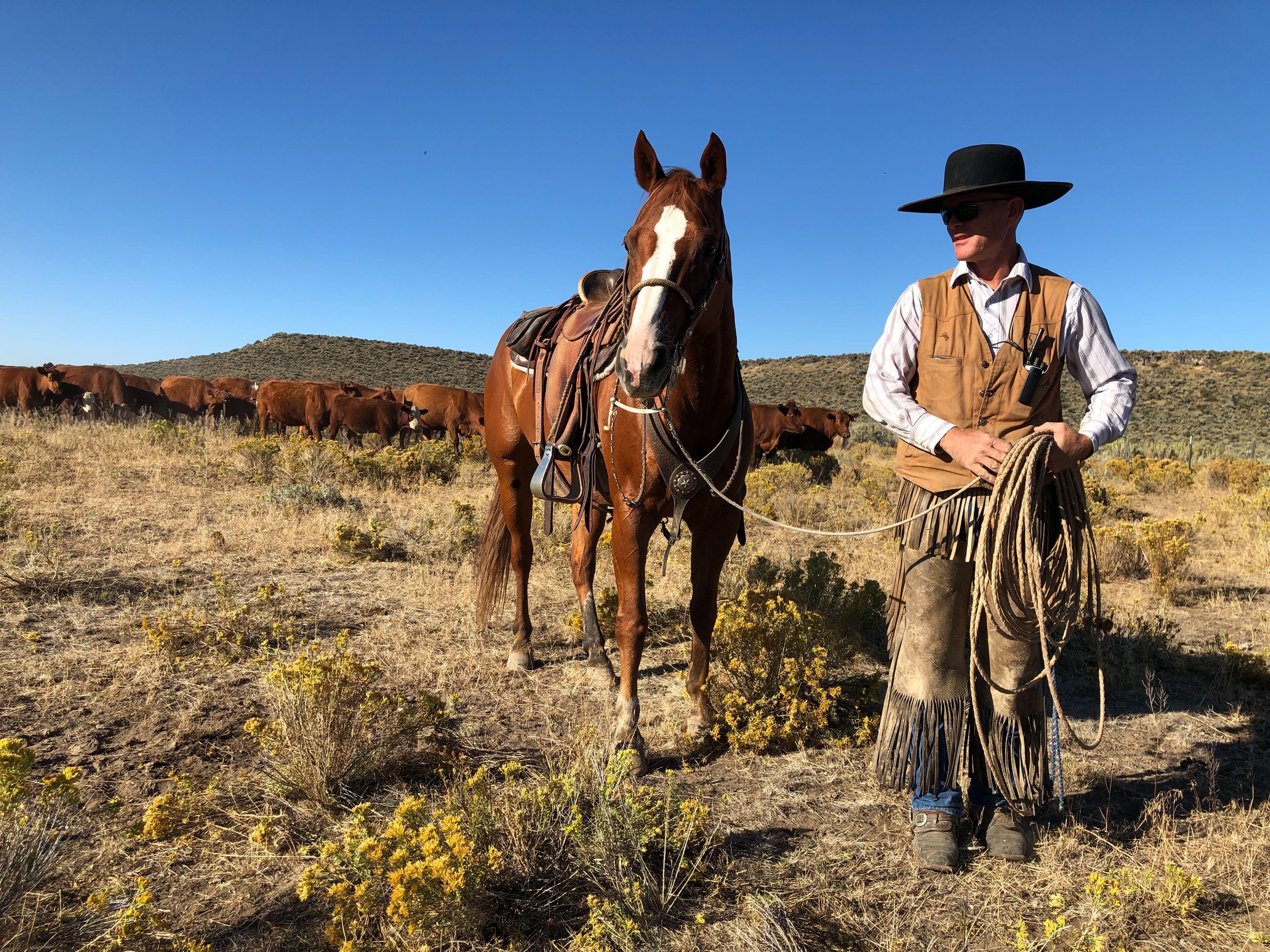
Clint Weaver, of Mt. Vernon, Oregon, is the cowboss or top herd manager of Silvies Valley Ranch outside of Burns. The ranch has endured at least five suspicious bull deaths this summer.
Producer: ANNA KING / NW News Network
Outside of Pendleton, Oregon, Terry Anderson’s cattle have messed up his irrigation spigots. Again.
The cows knock them down pretty much daily and he has to fix ‘em. He jumps out of his side-by-side vehicle and deftly rights them again or screws on a new spigot if they’re really bad.
“Cows just rub on stuff for the heck of it,” Anderson said with a smile. “They love to scratch.”
Not One Drop Of Blood
Right now in remote Eastern Oregon, a serial crime spree is unfolding. Young purebred bulls are mysteriously showing up dead. Cowboys recently found several animals with body parts precisely removed — and it’s happened just like this before in the West.
It happened to Anderson back in the 1980s, when one of the rancher's mother cows was mysteriously killed overnight. From his homeplace, Anderson pointed to the exact spot where he found her on top of a mountain. He's never gotten over it.
Anderson said he had just been near the spot the night before. The next morning, his cow was laid over and dead, her udder removed with something razor-sharp.
“And not one drop of blood anywhere,” Anderson said.
Everything You Do Leaves Tracks
Over 200 miles away — outside Princeton, Oregon — Andie Davies is canning green chili peppers in her remote ranch kitchen. The air smells spicy and warm. She wipes her strong, working hands before giving a shake.
Another cut up and bloodless cow was found two years ago a mile from her homeplace. A hunter discovered the carcass near a water trough just hours after the kill.
Her son, a butcher at the time, inspected the slain animal. He couldn’t understand how the cuts were made so clean.
Davies said she and her husband rode strategic circles around the area with four-wheelers to try and find vehicle tracks, horse tracks, something. They never found any. And in this country, “everything you do leaves tracks,” Davies said.
Silvies Valley Ranch
Over an hour away, north of Burns, Oregon, cowboys whistle and talk low to eager cattle dogs.
Dust from hooves, both cloven and shod, creates a fog in the early light. As they gather the cow-calf pairs out of a large draw, the animals call to each other.
Silvies Valley Ranch is nearly the size of Chicago. This summer, five young purebred bulls were cut down in their prime. Colby Marshall is the vice president of the ranch.
To understand what happened better, we rattled up a two-track U.S. Forest Service road.
“And we’re gonna drive in here,” Marshall said, “oh a little ways and then we’ll get out and take a little walk to where one [of] the bulls was found. And the carcass is still there.”
These animals were found bloodless, with their tongues and genitals precisely removed.
Coming upon one of the dead bulls is an eerie scene. The forest is hot and still, apart from a raven’s repeating caw. The bull looks like a deflated plush toy. It smells. Weirdly, there are no signs of buzzards, coyotes or other scavengers. His red coat is as shiny as if he was going to the fair.
Marshall said these young animals were just reaching their top value as breeding bulls. Now the animals, worth as much as $7,000 each, and their collective future progeny worth hundreds of thousands of dollars are lost.
Finding these rangey young Hereford bulls in this remote country can sometimes take the ranch’s experienced cowboys days. Marshall suspects a coordinated effort.
“It’s rugged,” he said. “I mean this is the frontier. … If some person, or persons, has the ability to take down a 2,000-pound range bull, you know, it’s not inconceivable that they wouldn’t have a lot of problems dealing with a 180-pound cowboy.”
Staff are now required to ride in pairs and encouraged to carry firearms.
Alien (And Other) Theories
In Burns, Oregon, Dan Jenkins is a deputy with the Harney County Sheriff's Office. Jenkins has been working the cattle cases and has received calls from all over.
“A lot of people lean toward the aliens,” Jenkins said. “One caller had told us to look for basically a depression under the carcass. ‘Cause he said that the alien ships will kinda beam the cow up and do whatever they are going to do with it. Then they just drop them from a great height.”
Jenkins said the cases have been tough, with little evidence and no credible leads. He personally inspected four of the animals. He has a running list on his whiteboard with the top theories.
“Another [person] told us we should run like a Geiger counter type thing around the animal and guarantees that there would be radiation there,” Jenkins said. “And the number one on the list there, he thinks it’s the North Vietnamese army.”
Whatever or whoever the cause, what’s clear is it isn’t bears, wolves, cougars or poisonous plants. Nor were the animals shot.
The FBI won’t confirm or deny it’s looking into the killings.
Little Time To Dwell
Back on Anderson’s spread near Pendleton, Oregon, he’s got his solid-set sprinklers running now.
The spigots hiss and sputter, then click, click.
What happened to his mother cow decades ago and these new cases leaves him with an uneasy feeling.
“But you just go on,” Anderson said. “‘Cause the next day has a lot of projects to get done, too.”
Ranching, after all, leaves little time to dwell.
